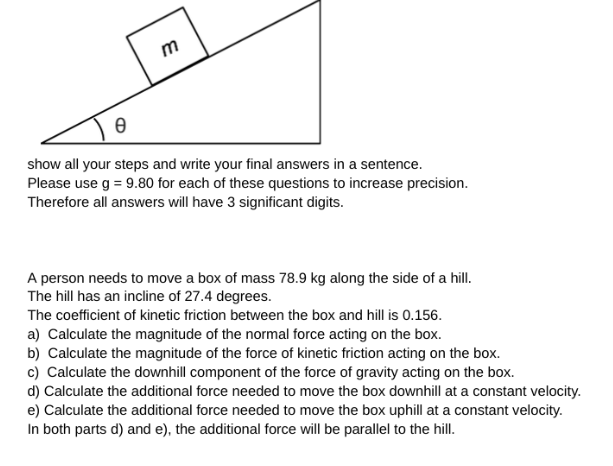Principles of Physics: A Calculus-Based Text
5th Edition
ISBN:9781133104261
Author:Raymond A. Serway, John W. Jewett
Publisher:Raymond A. Serway, John W. Jewett
Chapter4: The Laws Of Motion
Section: Chapter Questions
Problem 14CQ: Give reasons for the answers to each of the following questions: (a) Can a normal force be...
Related questions
Topic Video
Question

Transcribed Image Text:m
Ө
show all your steps and write your final answers in a sentence.
Please use g = 9.80 for each of these questions to increase precision.
Therefore all answers will have 3 significant digits.
A person needs to move a box of mass 78.9 kg along the side of a hill.
The hill has an incline of 27.4 degrees.
The coefficient of kinetic friction between the box and hill is 0.156.
a) Calculate the magnitude of the normal force acting on the box.
b) Calculate the magnitude of the force of kinetic friction acting on the box.
c) Calculate the downhill component of the force of gravity acting on the box.
d) Calculate the additional force needed to move the box downhill at a constant velocity.
e) Calculate the additional force needed to move the box uphill at a constant velocity.
In both parts d) and e), the additional force will be parallel to the hill.
Expert Solution
This question has been solved!
Explore an expertly crafted, step-by-step solution for a thorough understanding of key concepts.
Step by step
Solved in 6 steps with 1 images

Knowledge Booster
Learn more about
Need a deep-dive on the concept behind this application? Look no further. Learn more about this topic, physics and related others by exploring similar questions and additional content below.Recommended textbooks for you

Principles of Physics: A Calculus-Based Text
Physics
ISBN:
9781133104261
Author:
Raymond A. Serway, John W. Jewett
Publisher:
Cengage Learning

Physics for Scientists and Engineers: Foundations…
Physics
ISBN:
9781133939146
Author:
Katz, Debora M.
Publisher:
Cengage Learning

Principles of Physics: A Calculus-Based Text
Physics
ISBN:
9781133104261
Author:
Raymond A. Serway, John W. Jewett
Publisher:
Cengage Learning

Physics for Scientists and Engineers: Foundations…
Physics
ISBN:
9781133939146
Author:
Katz, Debora M.
Publisher:
Cengage Learning